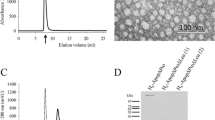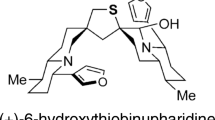Abstract
Microscopic examination of histological sections of lymph nodes from a canine case of malignant lymphoma at 4 h after treatment with L-asparaginase revealed massive destruction of neoplastic cells by what was consistent with apoptosis morphologically. Apoptosis as the mode of cell death after asparaginase treatment was confirmed in a mouse lymphoma cell line (LY-TH) by the characteristic fragmentation of DNA into oligonucleosome-sized pieces and by the morphological changes consistent with apoptosis following treatment in vitro. Applied to these cells, asparaginase was found to be most cytotoxic over the range of 1–10 IU/ml. Even after 4 h of asparaginase treatment at 100 IU/ml, protein synthesis was reduced by only one-half, yet DNA fragmentation reached 40%. Other agents that affect protein synthesis (cycloheximide and actinomycin D) caused apoptosis as well; however, agents (radiation, prednisolone, and VP-16) whose mechanisms are different from inhibition of protein synthesis also caused apoptosis. As such, it seems unlikely that protein depletion per se and/or the elimination of specific shortlived proteins is the triggering event that leads to cell death. It is more likely that the suspension of cellular proliferation commits cells to apoptosis after asparaginase treatment.
Similar content being viewed by others
References
Agarwal ML, Clay ME, Harvey EJ, Evans HH, Antunez AR, Oleinick NL (1991) Photodynamic therapy induces rapid cell death by apoptosis in L5178Y mouse lymphoma, cells. Cancer Res 51:5993
Asselin BL, Ryan D, Frantz CN, Bernal SD, Leavitt P, Sallan SE, Cohen HJ (1989) In vitro and in vivo killing of acute lymphoblastic leukemia cells by L-asparaginase. Cancer Res 49:4363
Broome JD (1981) L-asparaginase: discovery and development as a tumor-inhibitory agent. Cancer Treat Rep 65 [Suppl 4]: 111
Collins RJ, Harmon BV, Souvlis T, Pope JH, Kerr JFR (1991) Effects of cycloheximide on B-chronic lymphocytic leukemic and normal lymphocytes in vitro: induction of apoptosis. Br J Cancer 64:518
Ertel IJ, Nesbit ME, Hammond D, Weiner J, Sather H (1979) Effective dose of L-asparaginase for induction of remission in previously treated children with acute lymphocytic leukemia: a report from the Children's Cancer Study Group. Cancer Res 39:3893
Evan GI, Wyllie AH, Gilbert CS, Littlewood TD, Land H, Brooks M, Waters CM, Penn LZ, Hancock DC (1992) Induction of apoptosis in fibroblasts by c-myc protein. Cancer 69:119
Gallagher MP, Marshall RD, Wilson R, (1989) Asparaginase for the treatment of ALL. In: Marshall RD, Tipton KF (eds) Essays in biochemistry. Academic Press San Diego, p 1
Leeper DB, Schneiderman MH, Dewey WC (1973) Radiation induced cycle delay in synchronized Chinese hamster cells: comparison between DNA synthesis and division. Radiat Res 53:326
Martin SJ, Lennon SV, Bonham AM, Cotter TG (1990) Induction of apoptosis (programmed cell death) in human leukemic HL-60 cells by inhibition of RNA or protein synthesis. J Immunol 145:1859
McConkey DJ, Nicotera P, Hartzell P, Bellomo G, Wyllie AH, Orrenius S (1989) Glucocorticoids activate a suicide process in thymocytes through an elevation of cytosolic Ca2+ concentration. Arch Biochem Biophys 269:365
Prager MD, Bachynsky N (1968) Asparagine synthetase in asparaginase resistant and susceptible mouse lymphomas. Biochem Biophys Res Commun 31:43
Robertson AMG, Bird CC, Waddell AW, Currie AR (1978) Morphological aspects of glucocorticoid-induced cell death in human lymphoblastoid cells. J Pathol 126:181
Rogers KS (1989) L-asparaginase for treatment of lymphoid neoplasia in dogs. J Am Vet Med Assoc 194:1626
Rosenthal RC, MacEwen EG (1990) Treatment of lymphoma in dogs. J Am Vet Med Assoc 196:774
Searle J, Lawson TA, Abbott PJ, Harmon B, Kerr JFR (1975) An electron-microscope study of the mode of cell death induced by cancer-chemotherapeutic agents in populations of proliferating normal and neoplastic cells. J Pathol 116:129
Stephens LC, Schultheiss TE, Small SM, Ang KK, Peters LJ (1989) Response of parotid gland organ culture to radiation. Radiat Res 120:140
Stephens C, Ang KK, Schultheiss TE, Milas L, Meyn RE (1991) Apoptosis in irradiated murine tumors. Radiat Res 127:308
Story MD, Stephens LC, Tomasovic SP Meyn RE (1992) A role for calcium in regulating apoptosis in rat thymocytes irradiated in vitro. Int J Radiat Biol 61:243
Walker PR, Smith C, Youdale T, Leblanc J, Whitfield JF, Sikorska M (1991) Topoisomerase II-reactive chemotherapeutic drugs induce apoptosis in thymocytes. Cancer Res 51:1078
Waring P, Kos FJ, Mullbacher A, (1991) Apoptosis or programmed cell death. Med Res Rev 11:219
Wyllie AH, Kerr JFR, Currie AH (1980) Cell death: the significance of apoptosis. Int Rev Cytol 68:251
Author information
Authors and Affiliations
Additional information
This work was supported by NIH grants CA-06294 and CA-16672
Rights and permissions
About this article
Cite this article
Story, M.D., Voehringer, D.W., Stephens, L.C. et al. L-asparaginase kills lymphoma cells by apoptosis. Cancer Chemother. Pharmacol. 32, 129–133 (1993). https://doi.org/10.1007/BF00685615
Received:
Accepted:
Issue Date:
DOI: https://doi.org/10.1007/BF00685615




